Site Menu:
| This is an archived Horseadvice.com Discussion. The parent article and menus are available on the navigation menu below: |
| HorseAdvice.com » Diseases of Horses » Lameness » Diseases of the Upper Rear Limb » Overview of Diseases of the Hock (Tarsus) » |
| Discussion on Bone chip in hock | |
| Author | Message |
| Member: equinkel |
Posted on Saturday, Feb 20, 2010 - 9:51 am: I noticed after a training session that my 4 year old ottb has some inflamation in his right hock. He was/is not showing lameness. I had the vet come out right away and get xrays and they found 3 chips in the hock. Can you take a look at the xrays, location of the chips, and tell me what you think?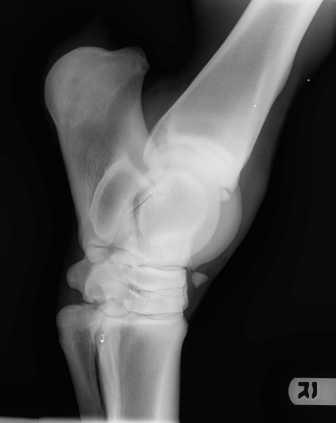 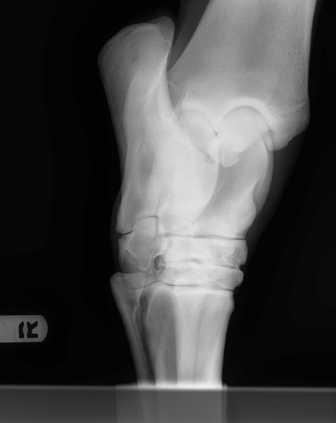 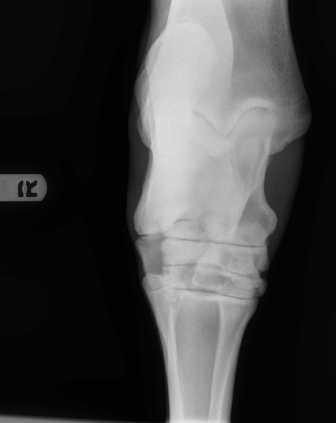 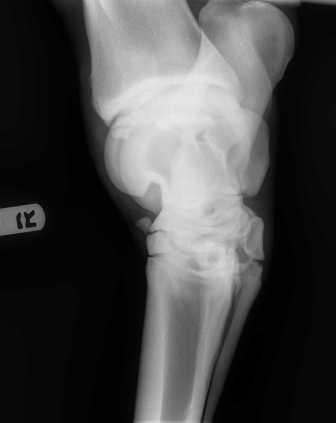 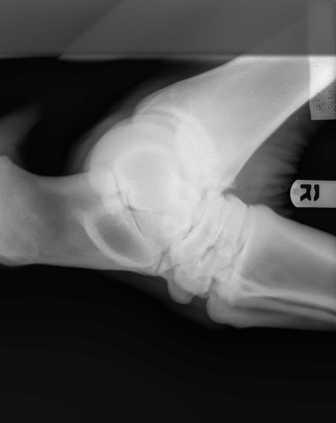
|
| Moderator: DrO |
Posted on Saturday, Feb 20, 2010 - 5:40 pm: Hello equinkel,Do to both time constraints and the internet image quality limitations I avoid such open ended radiograph review or opinions. Quickly reviewing the above images, I do make out the two large chips seen easily in the first image above. They are of a size and location and have a history that strongly suggests surgery will be required to try and prevent/minimize osteoarthritis from developing in the tibiotarsal joint. However a through review of the originals by a orthopedic surgeon should be done for assessment of lesions, potential treatments, and prognosis. I may be of more help if I have the written evaluation done by the fellow who has seen the originals. DrO |
| Member: equinkel |
Posted on Sunday, Feb 21, 2010 - 11:35 am: Since you don't feel comfortable giving your opinion on the xrays let's talk about injection vs surgery. I know the vet/surgeon is going to recommend orthoscopic surgery. I don't like the idea of having surgery unless absolutely necessary. Surgery seems to have it's complications as well. Even by having surgery it's no guarantee against future chips or lameness. Then you have scar tissue problems and so on. What are thoughts on managing this with injections? Xray every six months to manage any issues with future degeneration?I've also heard alot about hock fusion but I don't know exactly how it works or if has any connection with this particular case. I was planning on using this horse for low level eventing, hunter jumper, etc. Small fences nothing fancy. Other then swelling and a slightly less under step at the trot there is no other lameness. He also did not flex lame for the vet. The horse is currently 4.5 yrs old. |
| Moderator: DrO |
Posted on Sunday, Feb 21, 2010 - 6:02 pm: This is not a joint that can be fused equinkel. Only the distal two hock jts can be fused as they have little motion associated with them normally. This is in the main hinge of the hock.I don't believe injections, or other medical therapy are going to substantially effect the long term course of the irritation caused by these fragments. But again this would be a question best posed to a orthopedic surgeon who deals with these issues daily. If you do not trust your veterinarians assessment then have the radiographs sent to a second orthopedist for an opinion. DrO |
| Member: equinkel |
Posted on Monday, Feb 22, 2010 - 10:17 pm: The vet that took that the xrays is recommending surgery. I got a second opinion from another vet he said they ususally don't do surgery unless significant lameness is present. I still have not talked to the surgeon yet. I'm getting xrays tomorrow to see if there is damage to the other hock. If I decide to treat with injections what would be the best thing to minimize damage to the joint or at least slow it down as much as possible? |
| Moderator: DrO |
Posted on Tuesday, Feb 23, 2010 - 7:06 pm: This second veterinarian's opinion, has he seen the size of the defects and aware that signs of inflammation are occurring in that joint?For information on intra-articular treatments available see the treatment sections of Diseases of Horses » Lameness » Joint, Bone, Ligament Diseases » Arthritis and DJD: An Overview. DrO |
| Member: equinkel |
Posted on Tuesday, Feb 23, 2010 - 11:15 pm: I did show the 2nd opinion vet the xray. Upon reviewing my other post I would like to point out that the 2nd vet didn't say don't have surgery and leave it at that. He gave me three different scenerios. Surgery, Injection, or no treatment. We weighed my goals/situation, the history of the horse, and time frame. These were his exact words"Surgery: fragment removal is usually reserved for cases in which lameness is a significant problem, or intended use of the horse will be very strenuous and one wants to prevent lameness from being a problem later, or the appearance of the swelling is bothersome to the owner. Outcomes are frequently based on the individual surgeons' personal experiences" I did find other articles supporting his statement when I was doing some research. With all that being said, I did xray the other hock today and it showed no chips. It did show some slight degeneration. The swelling in the right hock has gone down 50% since sunday and I have not given any bute since then as well. I decided to do a series of adequan im as well. I'm not sure what effect this will have on his movement but in theory it should help slow down the degeneration process. I'm going to give my horse another week off and then start him back with light work and see how it goes. |
| Member: paardex |
Posted on Wednesday, Feb 24, 2010 - 9:15 pm: Just curious,hope you don't mind Equinkel, but what are your fears regarding operating? I've had a few operated and seen a lot of horses more that had been operated sometimes in three places at once and usually it was just a laparoscopy with very quick and without problem revalidation when they were operated before problems arrived?Jos |
| Member: equinkel |
Posted on Thursday, Feb 25, 2010 - 6:25 am: I'm not completely against surgery. I'm just against doing is right at this moment. I wanted to ride him for one season, see if he stays sound , see what type horse he will turn out to be in a years time. I was going to reevaluate next fall and make a decision from there. If I decide at that point to do surgery I can give him the whole winter off and not be tempted to start him back too soon. If I start riding him and he comes up lame then I probably will do the surgery asap. I'm curious to hear from the people that held off on surgery and what the outcome was. |
| Member: paardex |
Posted on Thursday, Feb 25, 2010 - 10:03 am: As far as I know[and Europe has an extensive amount of young warmbloods with bonechips alas, waiting causes a big risk of additional damage often NOT reversible.Furthermore after laparoscopie a week in a box and then 3 weeks handwalking and then slowly starting work was usual procedure, but Dr O might correct me there. The horses I talk about were usually 1,5 to 2,5 years old with only chips and no additional inflamation at that moment, as 'the sooner the better is point of view in between showjumper and dressage people for higher levels. Jos |
| Member: equinkel |
Posted on Saturday, Feb 27, 2010 - 8:22 am: I noticed a lot of the articles that I read related to very young horses as well. My horse is already showing some signs of degeneration in both hocks, the one with the chip and the one without. Not a lot, but some. I started him on adequan in hopes that it will significantly slow down this problem. I'm having a vet come out and do a complete lameness evaluation to see if there is any lameness that I missed. I will also ask him the rate of degeneration to expect if I wait a year to do the surgery. |
| Member: paardex |
Posted on Sunday, Feb 28, 2010 - 11:55 am: Hi Equinkel, yes most warmbloods get operated before they start working. You must be at a disadvantage as as far as I know the sooner you get the bonechips out the less damage to the joint. And an OTTB obviously has already worked.I guess in a way you are already stuck with somebody elses decisions. Good Luck and please keep us posted. Jos |
| Member: equinkel |
Posted on Monday, Mar 1, 2010 - 4:18 pm: This is a good article on ocd in race horses.https://www.salesintegrity.org/pdf/cba_ocd_book.pdf |
| Member: paardex |
Posted on Monday, Mar 1, 2010 - 9:50 pm: Completely different view on OCD as in Europe with Showjumpers and dessage horses.Biggest difference between a racehorse and a showjumper or dressagehorse according to a very good vet I went to a seminar on OCD of and talked to personally is that one expects aWB to work until 20 years of age at the highest level[he meant international] due to the long time it takes to train them for that level. In his vision and experience OCD even after operating cut the carreer of the horses short by appr. 20 % way to expensive to loose a fully trained showjumper at 16 instead of 20 for his job. He had the view[but stated that that still was NOT scientifically proven] that OCD arrived more often in horses with a less perfect bloodflow[? English IS difficult] which added to a sooner damaged joint. So obviously a racehorse is less bothered by OCD as WB as the carreer always is shorter anyway. I promote the point of view that it is better to breed horses that at the very least don't have the genetic disposition[In Europe thought to be MUCH more important then in the US I believe, almost all studbooks except it as hereditary by now]as it will only lenghten their carreer. Jos |
Horseadvice.com
is The Horseman's Advisor
Helping Thousands of Equestrians, Farriers, and Veterinarians Every Day
All rights reserved, © 1997 -
is The Horseman's Advisor
Helping Thousands of Equestrians, Farriers, and Veterinarians Every Day
All rights reserved, © 1997 -
